The Ultimate Guide to Large Dome Bird Cages for Avian Care
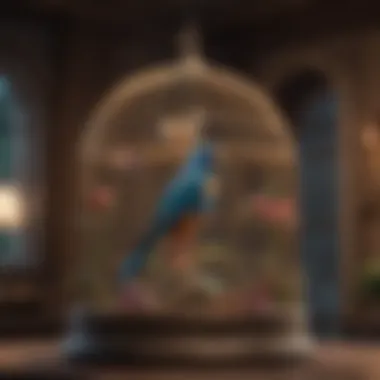
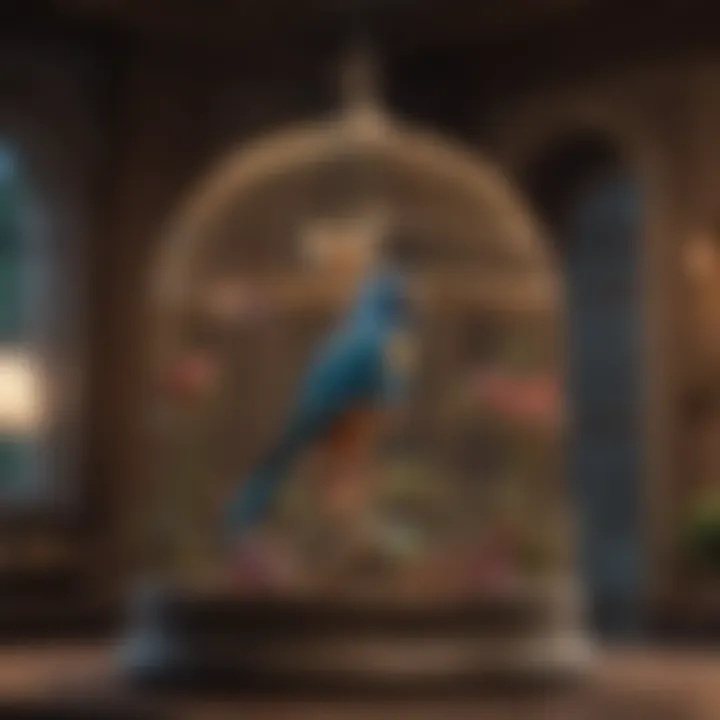
Intro
Large dome bird cages have become increasingly popular among bird enthusiasts for various reasons. These structures provide ample space for birds, allowing them to exercise and explore. Selecting the right cage is crucial for pet bird well-being, as it contributes significantly to their happiness and health. This guide will dissect essential characteristics and practices related to large dome bird cages, from daily care practices to fostering enrichment and mental well-being.
Care Tips
Caring for pet birds within a large dome cage demands a systematic approach. Proper daily maintenance not only keeps the inhabitants safe and healthy but also encourages social interaction and physical activity.
Daily Care Routines
Birds thrive on routine. Establish a daily schedule that includes feeding, cleaning, and social interactions. Monitoring their behavior during these routines helps in noticing any changes that may indicate stress or illness. Responding quickly to behavioral shifts is essential.
Cage Setup and Maintenance
Correctly setting up a large dome cage is important for the bird's comfort. Include appropriately sized perches, toys, and feeding stations to stimulate the bird physically and mentally. A regular inspection of these items ensures they remain safe and functional, which is vital for a bird's safety.
Hygiene and Cleaning Practices
Maintaining cleanliness within the cage is non-negotiable for the health of your bird. Use warm, soapy water to clean surfaces. Schedule a thorough cleaning once a week, removing waste and replacing bedding. Remember to frequently wash food and water dishes to prevent contamination.
Seasonal Care Adjustments
Changes in seasons bring new challenges and considerations. During colder months, ensure the cage is draft-free and perhaps add heating elements for comfort. In warmer months, pay attention to temperature control and humidity levels to reduce stress on your birds.
Behavioral Insights
Understanding the behavior of birds is essential for creating enriching environments. Observing their actions provides insight into their needs and discomforts.
Understanding Bird Body Language
Birds communicate many feelings through body language. Pay attention to stance, feather position, and vocalizations. Changes may indicate stress or-discomfort. Recognizing these signs early enables appropriate responses.
Common Behavioral Issues and Solutions
Behavioral issues can arise from improper cage arrangements or a lack of interaction. For example, excessive screeching or plucking feathers indicates distress. Address these issues with proper environmental enrichments, or consult avian professionals if necessary.
Positive Reinforcement Techniques
Training your bird using positive reinforcement can enhance their behavior. Utilize treats or favorite toys to encourage desired actions during play and training sessions. This fosters a trusting bond and encourages them to learn new skills.
Social Interaction Needs
Birds are social beings and often require interaction, whether with other birds or their human companions. Schedule regular playtimes outside the cage to satisfy their social needs and enhance their lives amidst avian and human company.
Nutrition Guides
A balanced diet is the cornerstone of avian health. Close attention to feeding practices can prevent many health problems.
Essential Diet Components
Pelleted diets serve as the main component, offering many nutrients. Supplement this with varied fruits, vegetables, and occasional grains to ensure a well-rounded diet, adjusting based on specific species needs.
Safe and Toxic Foods
It is critical to know what foods are safe and which are toxic. Avoid any elements of avocado, chocolate, or certain types of citrus fruits that can harm your bird. Always conduct research regarding edible options.
Supplements and Treats
Consider incorporating USDA-certified vitamins and minerals for additional health support. Treats can serve as excellent tools for training and bonding, provided they are nutri-tionally appropriate and portioned correctly.
Feeding Strategies for Different Species
Different bird species have varying needs. Join communities, such as reddit or facebook groups, where experienced owners share learning from their own trials and successes.
Wellness and Health
Holistic care goes beyond diet and hygiene; it involves maintaining overall well-being.
Routine Health Checkups
Regular veterinary checkups are vital to ensuring your bird's long-term health. Scheduled checkups can assist in spotting potential problems like feather issues, weight fluctuations, and the overall physical condition of your bird.
Identifying Symptoms of Illness
Keep lookout for subtle symptoms. Changes in appetite, lethargy, or feather appearance could hint at health concerns. Take action if notice you anything unusual to facilitate early intervention.
Preventative Care and Vaccinations
Consult with avian specialists about necessary vaccinations to which your bird is susceptible. Keeping consistent protocols enables swift attention as soon as potential health issues arise.
Mental and Emotional Well-being
Provide stimuli that engage physically and mentally. This adds to not only individuality and creativity but also stre-a-m of positive emotions that stimulate learning and exploration.
Enriching Activities
Diverse activities hold significance for maintaining creativity and stimulation. Designers out of toys and human interaction play pivotal roles.
Toys and Playtime Ideas
Rotate toys frequently to maintain novelty. Rope swings, mirrored surfaces, and foraging materials can enliven daily routines, providing psychological engagement. Connecting these items with floor time allows additional expeditious opportunities for exploration.
Training and Tricks
Basic training can boost mental capacities. Start with simple tricks reinforced through positive association, such as touching a pole or flipping when ready. Provide accolades for each accomplishment to strengthen learning fodder.
Outdoor Activities and Interaction

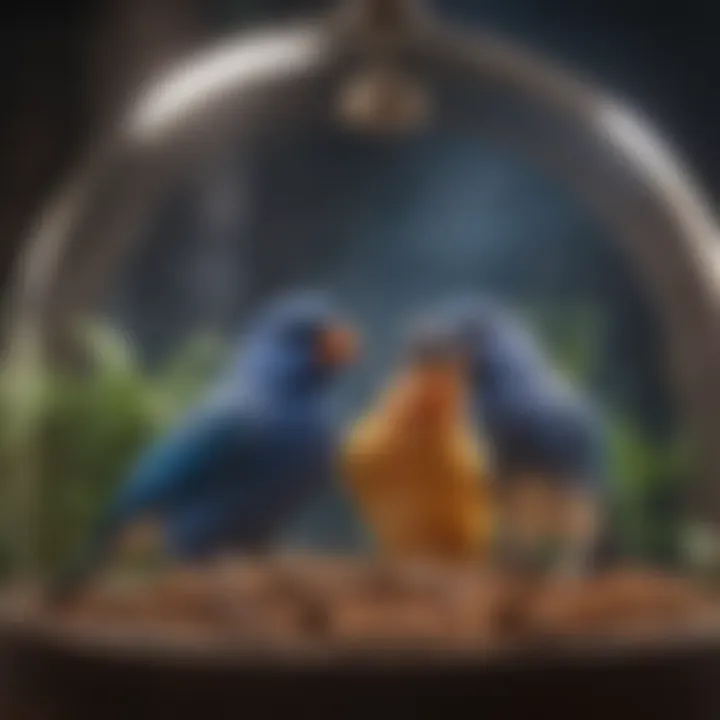
Regular outings ensure physical body and mind activity. Stepping outside for fresh air and supervised exploration generates xciting experiences. Ensure all safety measures are in place to protect against danger.
DIY Projects for Mental Stimulation
Conceiving your custom toys and activities can be both a fun and enlightening way for your bonds to grow. Simple daiy projects using materials like cardboard can provide stimulation on a shoestring budget, ensuring endless engagement for your pet birds.
“The right environment nourishes more than just the body; it nurtures the mind and spirit.”
Concluding, bonding with your avian friends demands input in their options. Dominant characteristics such as correct care routines, ameliorating behavior understanding contribute significantly to their productivity and joy. Extraordinary knowledge about avian anatomy, habits, diet cycles, and incorporating these routines seal promises of wellness in their lasting companionship.
Prolusion to Large Dome Bird Cages
Large dome bird cages offer a unique solution for pet bird owners looking to provide a spacious and stimulating environment for their feathered friends. In this article, we will explore their significance, benefits, and key features. Choosing the right habitat is crucial for maintaining the health and happiness of pet birds. Dome cages are designed not just for aesthetics, but also for functionality, addressing the natural behaviors and needs of avian species.
Why Choose a Large Dome Bird Cage
A large dome bird cage provides ample space for activities. Birds require space to fly, play, and explore. A cage with plenty of room will keep your pet engaged and can prevent behavioral issues caused by stress or boredom. Furthermore, a dome design often gives a sense of openness. Birds typically feel less confined when they can see their surroundings clearly.
Additionally, the unique shape of dome cages can facilitate social interaction among multiple birds. Many owners find that having ample vertical space allows for easy perching locations and creative arrangement options. Keeping a group of birds can lead to happy flocks, fostering natural social behavior where they can interact with each other more freely. This setup enhances their overall quality of life, reducing loneliness and encouraging bird-to-bird interaction.
Key Features of Dome Cages
When evaluating large dome bird cages, there are essential characteristics to consider. Here are some of the most important features:
- Spacious Interior: A larger footprint allows for the essential movement. Birds can experience increased physical health through active exploration within the cage.
- Safe Grills and Materials: Sturdy materials ensure that dangers are minimized. This selection not only protects birds but also supports a safe living environment.
- Multiple Levels: Some dome cages are designed with varying heights that allow for perches and facilities for sitting at different levels. This encourages natural behaviors and lets birds feel less threatened.
- Easily Accessible Doors: A large cage with front-access doors simplifies the process of cleaning and routine maintenance. Efforts to enter the cage should maintain the established peace for your pet.
A well-designed dome cage can blend functional considerations with elegance, making it easier for pet owners to create an inviting haven for their feathered companions. In summary, the choice of a large dome bird cage is critically influential in terms of health, well-being, and comfort for pet birds.
Understanding Bird Requirements
Understanding the requirements of birds is essential for any prospective or current bird owner. This concept encompasses the unique aspects of a bird's health, behavior, and living conditions. Since bird cages significantly influence these requirements, it is crucial to select a large dome bird cage that meets these needs effectively. In this section, we will delve into three fundamental elements: space and movement, social interaction needs, and environmental enrichment.
Space and Movement
Birds are naturally active creatures. They often require ample space to move, fly, and exercise. Providing enough room helps prevent various health issues, like obesity and muscle atrophy. A large dome cage allows birds to enjoy their physical needs. But how much space is enough?
- The ideal setup varies according to the species. Smaller birds may require less space compared to larger species like macaws.
- Movement through flight is not only a physical exercise but also crucial for mental health. Enabling birds to flap their wings and take mini-flights within their cage fosters good health.
In short, the roominess of a large dome bird cage strikes a balance to satisfy those natural urges. The craftsmanship allows neighboring birds in the same household to thrive without overcrowding too.
Social Interaction Needs
Birds are innately social animals. Many species communicate, play, and form bonds with other birds and even humans. A large dome bird cage can facilitate this vital interaction:
- Placing multiple birds within one cage can encourage companionship, promoting a healthier lifestyle.
- Birds that fail to interact may experience stress and exhibit problematic behavior. Social needs should never be compromised.
Understanding their social requirements helps bird owners ensure their pets are not isolated both physically and emotionally. Thus, utilizing dome cages with ample space becomes paramount.
Environmental Enrichment
Environmental enrichment plays a significant role in a bird's daily routine. This term refers to a range of activities and gazing objects present within a cage that triggers exploration and mental challenges:
- Curved surfaces and changing levels of a dome cage can engage your bird in movement and curiosity.
- Include diverse toys, natural wood perches, and platforms for your birds. Changing and rotating items can sustain their interest over time.
- Indoor plants or natural materials can add variety and certain safety, reflecting a gentle taste of their homeland, a concept significantly appreciated by species that are used to specific habitats.
So, taking careful note of how to supply this environment aids their sudden shifts in thought and mindset - helping to combat boredom. As birds often vocalize dissatisfaction from lack of entertainment, upkeep in environmental engagements becomes essential.
In summary, understanding bird requirements lays the foundation for satisfactory avian care. Meeting their need for space, socializing, and enrichment proves victorious in fostering a home conducive to happy and thriving birds.
Exploring Dome Cage Design
Exploring the design of dome cages is crucial for bird owners who want to ensure that their birds have a comfortable and safe environment. Dome cages offer unique structural elements that distinguish them from traditional square cages. Understanding these aspects helps owners make informed choices for their feathered companions. This section explores materials, size considerations, and features that enhance the cage experience for birds.
Materials and Construction
The choice of materials significantly impacts the longevity and safety of large dome bird cages. Materials used can range from sturdy metal frameworks to luxurious wooden structures. Sturdy metals like stainless steel are ideal as they resist rust, providing durability in various environments. Conversely, wood can present risk if it is not properly treated. It can harbor dirt or bacteria if not cleaned frequently. A high-quality construction ensures the cage can hold its shape and resists wear and tear over time. Owners must also consider whether the materials employed in the cage design are non-toxic to birds. This ensures their safety while navigating their confines.
Not all wood is safe. Make sure any wood used is treated properly and free of harmful chemicals.
In addition, the mesh and bars of the cage should be adequately spaced. This prevents escape while allowing for proper visibility. The overall construction technique can affect ease of assembly and disassembly. Responsiveness to routine cleaning needs plays an important role in promoting avian health and hygiene as well.
Size Considerations
The size of the dome cage is key in giving birds enough room to move, play, and rest. A larger cage allows for more freedom, which can improve bird mood and health. Each species has its specific spatial needs. For example, a parrot may need a cage that not only allows for space to spread its wings but also accommodate toys and branches for climbing.
When looking at size, choose cages that best serve the active or sedentary nature of the bird. Generally, larger dome cages will offer benefits that smaller cages cannot, such as multiple levels and space for various activities. A carefully measured room within your home to house the cage is also a vital consideration since placing a dome cage in a cramped corner limits its effectiveness.
Ventilation and Accessibility Features
Proper ventilation is paramount in maintaining a healthy environment within dome cages. Airflow contributes to reducing odor, moisture, and the growth of mold or bacteria. Dome design provides ample natural ventilation due to the rounded top, unlike many rectangular models. This helps regulate temperature, ensuring your pet bird remains stress-free even when it is warm.
Accessibility features also enhance the usability of the cage for both birds and their owners. Door placements should allow for easy access for cleaning and interaction without compromising the bird's safety. Detachable food and water containers can also aid in routine care while preventing spillage. Consider implementing perches and other features in ways to encourage access to the entire cage area. Doing so creates an interactive environment, enhancing the cage experience for birds.
Aspects of cage design profoundly influence bird welfare. Thus, knowledge and careful consideration of components help owners optimize their birds' living arrangements.
Benefits of Large Dome Bird Cages
Large dome bird cages serve several essential benefits that extend beyond aesthetic value for pet owners. Understanding these benefits is pivotal for anyone considering avian care. With the proper design, a large dome cage enhances both the quality of life for birds and the satisfaction of the owner. Here, we will explore three key advantages: improved avian health, enhanced aesthetic appeal, and versatility in design and use.
Improved Avian Health
One significant advantage of large dome bird cages is their impact on the health of the birds housed within them. Of paramount importance is the amount of space these cages provide. Birds require room to move, fly, and exhibit natural behaviors. Inadequate space can lead to various health issues, including obesity and stress-related disorders.
Dome cages generally provide a spacious environment, which allows birds to stretch their wings and engage in physical activity. This contributes positively to their overall health. Moreover, larger cages tend to promote better socialization among multiple birds, reducing anxiety caused by confinement. The chance for social interactions vastly impacts their mental health, allowing for a more fulfilling life.
"A well-designed dome cage can be instrumental in mimicking a bird's natural habitat, facilitating better physical and psychological well-being."
Enhanced Aesthetic Appeal
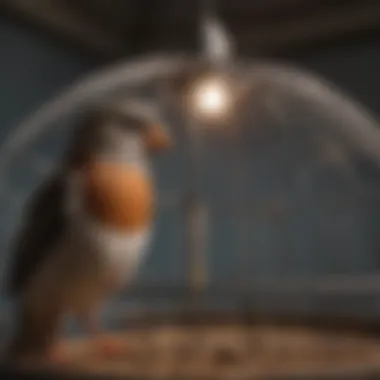
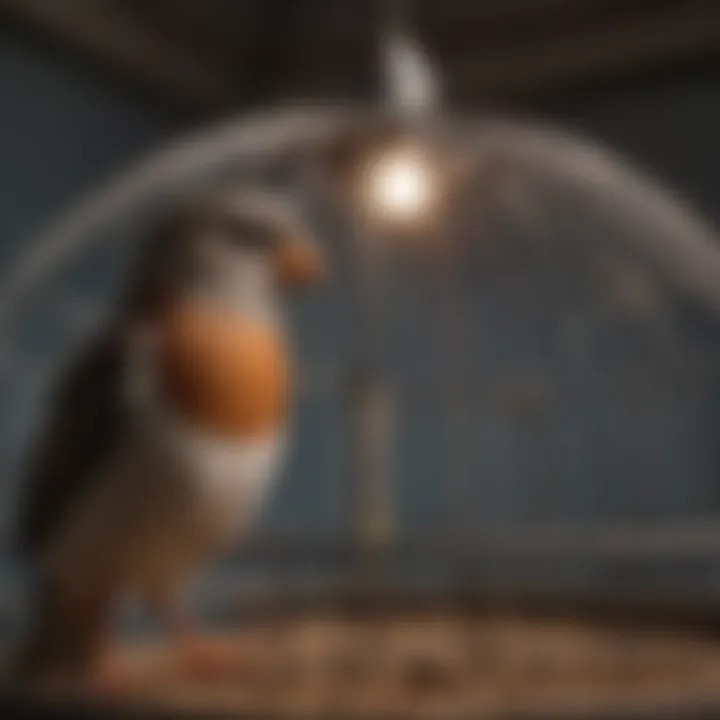
The design of large dome bird cages also meets a number of aesthetic considerations that attract bird owners. These cages add an element of elegance to a room, blending functionality with style. The rounded shape often offers a unique look compared to traditional square or rectangular cages. A dome cage can be a visual point in your home, showcasing your pet while also emphasizing your interior design.
In addition to their visual appeal, many dome cages come in various materials and color schemes, enhancing versatility. The ability to choose structures that match home decor allows owners to highlight birds as part of their living space. It creates a richer environment for both owner and pet. It's essential to recognize how combining form and function not only elevates the enclosure but also contributes to the well-being of the pet inside.
Versatility in Design and Use
Large dome bird cages offer incredible versatility, suitable for a wide range of bird species. Their interchangeable accessories make them adaptable to different bird requirements. From perches to food dishes, adjustments can be easily made to suit the specific needs of various birds.
Furthermore, dome cages facilitate different uses. They can serve solo or multi-bird environments, as open designs encourage integration. They can also transform spaces easily, accommodating room shifts or seasonal movements within the home. This flexibility ensures that the cage can grow with the needs of the owner and their birds, creating a sustained beneficial relationship between them.
Choosing the Right Cage for Your Bird
Choosing the appropriate cage for your pet bird is a crucial part of responsible avian care. The right enclosure ensures your bird’s comfort, safety, and well-being. A large dome bird cage is one option that provides ample space and can mimic a natural environment.
A well-selected cage affects bird behavior, health, and mood. The implications are long-term and affect not only the bird's experience but also the relationship between the owner and the pet. Before making a decision, several specific elements merit examination: your bird’s unique needs, the available models, and the balance between costs and value.
Assessing Your Bird’s Needs
Understanding your bird’s specific requirements is the first step in selecting a suitable cage. Different species have varied needs in terms of space, social interaction, and behavior. Some species thrive in larger areas, require significant engagement, and prefer numerous accessories. Consider the following factors:
- Species-Specific Atmosphere: Each bird species has natural behavior. Parrots might need more climbing space, while canaries may prioritize a safe and snug area.
- Social Habits: Birds often need interaction, not just with humans but with other birds. Determine if your bird will live alone or join a flock
- Play and Exploration: Birds are naturally curious. Make sure the cage allows adequate room for toys, perches, and possibly a hidden corner for comforting privacy.
Researching Brands and Models
Not all cages are created equal. It is significant to research different brands and models suitable for large dome bird cages. Each manufacturer offers unique features, constructions, and materials. Valuable considerations include:
- Material Quality: Ensuring that the cage does not have harmful coatings or weak materials. Stainless steel is often a good choice for its durability and safety.
- Cage Size and Design: Make exeptional for features like bars spacing that prevents escape or injury and ensures the doors are easily operable.
- Customer Reviews: Gathering feedback and experiences from current users provides insight on durability and trial runs of interacting with the cages. Many online platforms like reddit.com contain relevant user reviews which can be incredibly helpful.
Cost versus Value Considerations
Underpinning the choice of cage is the relationship between costs and the value offered by the product. Investing in a good cage is often seen as a long-term benefit. Price alone doesn’t measure how well a cage will benefit your bird. Weigh the following aspects:
- Upfront Cost vs Ongoing Investment: Basic models may save money initially but could require replacements sooner.
- Brand Reputation: Well-known brands may be pricier, but they often ensure quality, longevity, and safety features lacking in cheaper substitutes.
- Functionality and Safety: Understanding which cage provides necessary features that prevent behavior issues can justify its better price.
In summary, selecting the right cage entails thoughtful evaluation of your individual bird's requirements. By assessing needs properly, researching options wisely, and balancing price with quality, the right decision emerges. A fitting dome cage fosters a better habitat, supporting both bird and owner in the long run.
Setting Up the Cage Environment
Setting up the cage environment is crucial in ensuring the well-being of your pet bird. The choices made during this process can significantly impact their physical and mental health. General ambiance, safety, and stimulation levels all play a role in your bird's happiness. Therefore, the elements of a properly set up cage environment require consideration and planning.
Choosing Suitable Accessories
Selecting suitable accessories is an important step in establishing a nurturing space for your bird. The cage should be equipped with perches, toys, food dishes, and other items that encourage natural behaviors. The perches should vary in thickness and material, as different surfaces help strengthen your bird's feet and prevent boredom. Wooden perches, hemp ropes, and natural branches offer various textures that birds may enjoy.
Toys should be chosen based on the personality and habits of your bird. Activities like chewing, tugging, and swinging are natural for many species, so ensure a selection that offers both mental and physical stimulation. Incorporate items like foraging toys, mirrors, and bells to stimulate engagement. It's pivotal to rotate toys regularly to maintain interest and prevent the environment from becoming stale.
Placement in the Home
The placement of the bird cage within your home can greatly affect its atmosphere. Cages should be placed in a room where your bird can interact and socialize with family members but away from extreme temperature changes or dangers like open windows and drafts. Additionally, if possible, provide a view outside. Birds enjoy looking at the outside world. However, ensure they are not exposed to harsh sunlight that can overheat their cage.
Prioritizing stability is important while also promoting a vibrant social environment. Cages that are too high or too low may not align with your bird's comfort. Similarly, areas with high foot traffic or loud sounds may stress some species and should be avoided.
Maintaining a Clean Habitat
Keeping a clean habitat is essential to promoting good health for your pet. Regular cleaning practices help prevent disease and create a safe, pleasant environment. Start by removing debris and changing the bedding at least once a week. This will reduce odors and ensure its hygiene.
For food and water dishes, clean them daily to prevent mold and bacteria buildup. Additionally, consider using bird-safe cleaning materials to ensure that no harmful residues remain that might endanger your bird. The overall cleanliness across the substrate, toys, and perches cannot be overstated. It fosters a healthier living space and a happy bird.
Remember: A well-maintained cage supports both physical health and artisic sounds, allowing your bird to display their vibrant nature.
Caring for Your Bird in a Dome Cage
Caring for a bird in a dome cage is essential for ensuring that it leads a happy and healthy life. The spacious design of dome cages allows for increased movement, promoting better physical health for the bird. However, the responsibilities involved in bird care extend far beyond just providing a cage. This section will cover routine cleaning practices, health monitoring, and effective feeding strategies designed to support avian well-being.
Routine Cleaning Practices
Maintaining cleanliness in your bird's environment is crucial. Regular cleaning ensures that your pet remains free from disease and stress. At minimum, you should clean the cage once a week. However, daily checks for droppings and spilled food are also necessary. Using a vacuum specifically designed for small messes can help maintain cleanliness without a vigorous rubbing motion that may scare the bird.
Here are some steps to follow for efficient cleaning:
- Remove all accessories, food and water containers before cleaning.
- Wash the cage with hot soapy water. Avoid strong chemical cleaners, as these can harm birds.
- Rinse thoroughly to ensure no soap residue remains.
- Dry completely prior to reassembly.
- Sanitize the food and water bowls weekly to prevent mold buildup.
By employing these cleaning practices, you safeguard your bird’s health, giving it a suitable environment to thrive.
Regular Health Monitoring
Birds, like any other pets, require regular health checks. Birds can be prone to undetected illnesses, making routine monitoring vital. Key signs you need to watch for include changes in behavior, such as excessive lethargy or unusual vocalizations and alterations in appetite.
It's essential to schedule annual check-ups with an avian veterinarian, who can perform screenings and vaccinations. Additionally, knowing common signs of illness can help you address problems before they escalate. This incorporates:
- Understanding what is normal for your bird's appearance (plumage, eyes, beak).
- Monitoring your bird's activity levels. A decrease may indicate health concerns.
- Keeping an eye on droppings. Consistency and coloration can inform you of your bird's health status.
By engaging in regular health monitoring, you can potentially avoid serious health issues, ensuring your bird stays vibrant and lively.
Feeding Strategies for Avian Well-Being
Proper nutrition is at the core of a bird’s health. Birds are not one-size-fits-all animals, and their dietary needs will differ based on species, age, and health. A balanced diet usually consists of pellets, seeds, and fresh fruits and vegetables.
To develop a well-rounded feeding routine, consider the following:
- Offer fresh foods daily. Birds may become bored with their diet if only provided seeds.
- Limit seed intake. Seeds can be high in fat. Instead, supplement with nutritious pellets designed for your bird species.
- Research specific feeding guidelines for your bird. Some of the more specialized birds have unique dietary requirements that must be followed closely.
- Encourage foraging behavior by hiding food within friendly toys or puzzles.
Integratinig these strategies creates not only a nutritional diet but also keeps your bird mentally stimulated.
Regular engagement in cleaning, health checks, and proper nutrition strengthens the bond between you and your avian companion. Investing time in these practices fosters a sustainable and positive environment for your bird.
Overall, understanding the proper care techniques for birds in dome cages leads to happier, healthier avian companions.
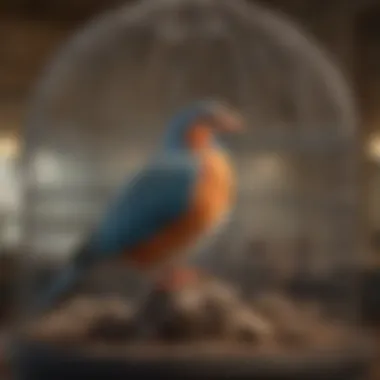

Troubleshooting Common Issues
Ensuring the well-being of pet birds in large dome cages often requires addressing various challenges that may arise. This section highlights common issues, emphasizing the importance of proactive troubleshooting for optimal avian welfare. Understanding how to address these issues enhances the living conditions for the birds and fosters a positive relationship between the pet and the owner. Such considerations reinforce the value of knowledgeable pet ownership.
Behavioral Problems in the Cage
Behavioral problems are a significant aspect of avian care that owners need to observe and manage. Birds, although resilient, can exhibit signs of stress and frustration when confined inappropriately, even in a spacious dome cage. Common behavioral issues include excessive screaming, feather plucking, and destructive behavior.
Factors Contributing to Behavioral Issues
Various factors can influence a bird’s behavior. These may include:
- Inadequate social interaction
- Lack of environmental enrichment
- Ill health or discomfort
To mitigate these behavioral problems, owners must implement multiple strategies. Providing positive reinforcement, engaging in play, and matching the cage accessories to the bird’s specific preferences can lead to a more harmonious environment.
"Understanding the complexities of bird behaviour allows owners to create a nurturing atmosphere, enhancing overall quality of life."
Addressing Safety Concerns
Safety is paramount when housing birds in a dome cage. Knowing the secure settings and potential hazards is essential. This specifically becomes imperative as birds are naturally curious creatures, exploring and potentially ignoring the dangers around them.
Key Safety Guidelines
To maintain safety in large dome bird cages, consider the following tips:
- Avoid harmful materials: Ensure all accessories are bird-safe and non-toxic.
- Secure the cage: Make sure all doors and locks are in working order to prevent escape.
- Monitor interactions: If sharing the environment with other pets, monitor their interactions to prevent any threatening situation.
Regular inspections of the cage and its components can significantly reduce safety issues. Observing the bird’s behavior provides insights into its comfort level. Building a safe and inviting environment contributes greatly to happier and healthier birds.
The Role of Dome Cages in Avian Welfare
The significance of large dome bird cages extends beyond mere functionality; their design fundamentally influences the overall welfare of pet birds. With increasing recognition of the connection between environment and animal well-being, choosing the right type of cage becomes crucial. Dome cages make a substantial contribution to avian comfort and mental health, acknowledging the unique needs of birds as both social and active creatures. Understanding the positive impacts these cages have on bird behaviour and natural instincts can make a difference in how pet birds thrive.
Impact on Bird Behavior and Mood
Dome cages provide a spacious environment which is key to fostering positive behaviours. Unlike traditional square cages, the rounded design allows for more vertical and horizontal movement. This architecture promotes exercise, which is essential for physical health. Birds kept in cramped spaces often display signs of stress or frustration, manifesting in destructive behaviour or excessive vocalization.
With plenty of space to explore, birds adapt well and show reduced territorial aggression since they feel less confined. Studies show that birds in spacious environments are also less anxious, allowing for calmer behaviours over time. Other impacts on behaviour could include increased playfulness and lower rates of feather picking.
Advantages of sizable space:
- Reduced stress: More room to roam leads to peace.
- Social interactions: Fosters better bonding with both humans and other birds.
- Exploration: Encourages natural exploration, stimulating their minds.
Conversely, a negative cage environment can results in poor mood states affecting overall avian health. Dome cages help minimize these risks through adequate space and design flexibility, ultimately elevating mood and reducing undesirable behaviours.
Promoting Natural Instincts
Dome cages also align closely with birds’ natural instincts. The geometry allows for a better mimicry of their native habitat, giving these pets opportunities that encourage their instinctual behaviours. The spacious, open design lets birds engage in flying, hopping and climbing behaviors to their utmost capacity. Birds also appreciate height in their habitat as they often perch high up in wild.
A dome shape cages allow owners to add branches, ropes and platforms which can further stimulate these natural behaviors. Incorporating these elements within the cage environment can lead to more satisfying conditions where birds can exhibit desired instincts such as foraging. Regular amenities such as swings or mirrors also encourage exploration and enjoyment.
Key factors for stimulating natural instincts include:
- Including scratching branches
- Assembling multiple perching heights
- Implementing adventure toys for entertainment
The appreciation of a more natural setting helps not just in improving their behaviours but also connects back to fostering an useful sense of contentment for avian welfare as a whole.
A well-designed dome cage reflects the natural environment from which the bird originates.
Comparing Dome Cages to Other Designs
In the landscape of avian housing, the choice of cage can significantly affect a bird's environment and well-being. Therefore, comparing dome cages to other designs serves to illuminate specific advantages that dome cages present for both birds and their owners. Dome cages, with their unique structure and design benefits, often provide enhanced living conditions for pet birds compared to traditional square cages or other forms.
Square Cages Versus Dome Cages
Square cages, while common, can limit the space needed for birds to express their natural behaviors. These cages generally have a rigid structure that may not provide an environment conducive to movement. Comparatively, dome cages have a spacious, rounded upper section allowing for improved airflow and visual access to owners or surroundings. Thus, birds may experience less stress in dome cages due to their widened field of vision and potential for more dynamic interactions.
From a practical perspective:
- Freedom of Movement: Dome cages allow birds to move more freely in different directions without the restrictions often encountered in square alternatives.
- Behavioral Enrichment: With the added height and space, birds can flap and stretch their wings more comfortably, which refreshes their energy and fosters natural instincts.
- Visual Stimulation: The configuration permits a variety of perches and toys at different heights, encouraging climbing and engagement.
Functionality and Design Aesthetics
Dome cages although designed chiefly for functionality, also offer aesthetic advantages. Their form typically presents a more visually appealing choice in home decor compared to the more utilitarian square cages. These cages can often act as a centerpiece in a room rather than a mere living space for birds. The design and functionality seamlessly align; a dome cage does not have to sacrifice aesthetics for practicality.
Key points of value include:
- Synergistic Design: Stylish dome cages come in various finishes and materials that can illuminate a living space, blending durability with appearance.
- Enhanced Features: Many modern dome cages now incorporate user-friendly features—a case in point being removable trays for cleaning, which plays a vital part in maintaining hygiene.
- Versatile Decor: Choices in base color and materials can make selecting a dome cage a fun task, adding character and elegance to any room.
Ultimately, the mindful selection between dome cages and other designs should take into account not only the practical needs of the bird but also the aesthetic qualities desired in pet ownership.
Choosing a dome cage could enhance not only your bond with your bird but also the overall quality of the bird's life. Thus, as a potential bird owner, reflect seriously on these aspects before making a purchase.
Ending
Birds have complex needs that require detailed attention from their owners. Large dome bird cages serve a significant role in addressing these needs. One key advantage is the ample space they provide, allowing birds to move freely and exhibit natural behaviors. Furthermore, numerous design features cater to aspects like ventilation, accessibility, and enrichment. This variety ensures that bird owners can tailor their pet's environment to enhance well-being.
Recap of Key Points
Several fundamental aspects highlight the importance of large dome bird cages:
- Space and Movement: Large dome cages enable birds to fly and hop comfortably, improving their physical health.
- Social Interaction: The dome design allows for better interaction with both human owners and potential companions, reducing loneliness.
- Environmental Considerations: These cages typically provide better air circulation and various places for perching and nesting.
- Feeding and Accessibility: Easy access to food and water encourages proper diet and hydration.
"Adequate living spaces directly correlate with enhanced avian psychological health."
Being educated about the considerations for choosing a cage, understanding maintenance, and promoting enrichment ensures a better environment for pet birds.
The Future of Avian Housing
As advancements in construction materials and ecologically friendly practices occur, the future of avian housing looks promising. Innovative designs are likely to emerge, featuring more ergonomic structures examples of which could be modular components aimed at better accommodating diverse avian species. Additionally, the growing awareness surrounding bird welfare is likely to influence consumers toward informed choices. Bird owners must keep an eye on these trends as they strive to provide optimal housing environments for their feathered friends. Further, continued discussions on these platforms can advocate for better practices in breeding and cage design.
As the demands of modern birds evolve, their living arrangements will need to adapt. Emphasis on spacious designs and enriching environments will likely become more common in product offerings. Bursting earlier notions of traditional cage styles, these new approaches seem promising to enhance bird welfare significantly.















